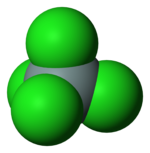Silicon tetrachloride
|
| |||
| Names | |||
|---|---|---|---|
| IUPAC name
Silicon (IV) chloride
| |||
| Other names
Silicon tetrachloride
Tetrachlorosilane | |||
| Identifiers | |||
3D model (JSmol)
|
|||
| ChemSpider | |||
| ECHA InfoCard | 100.030.037 | ||
| EC Number |
| ||
PubChem CID
|
|||
| RTECS number |
| ||
| UN number | 1818 | ||
CompTox Dashboard (EPA)
|
|||
| |||
| |||
| Properties | |||
| SiCl4 | |||
| Molar mass | 169.90 g/mol | ||
| Appearance | Colourless liquid | ||
| Density | 1.483 g/cm3 | ||
| Melting point | −68.74 °C | ||
| Boiling point | 57.65 °C | ||
| decomposes | |||
| Solubility | soluble in benzene, toluene, chloroform, ether | ||
| Vapor pressure | 25.9 kPa at 20 °C | ||
| Structure | |||
| Tetrahedral | |||
| 4 | |||
| Hazards | |||
| NFPA 704 (fire diamond) | |||
| Related compounds | |||
Other anions
|
Silicon tetrafluoride Silicon tetrabromide Silicon tetraiodide | ||
Other cations
|
Carbon tetrachloride Germanium tetrachloride Tin(IV) chloride Titanium tetrachloride | ||
| Supplementary data page | |||
| Silicon tetrachloride (data page) | |||
Except where otherwise noted, data are given for materials in their standard state (at 25 °C [77 °F], 100 kPa).
| |||
Silicon tetrachloride is the inorganic compound with the formula SiCl4. It is a colourless volatile liquid that fumes in air. It is used to produce high purity silicon and silica for commercial applications.
Preparation
Silicon tetrachloride is prepared by the chlorination of various silicon compounds such as ferrosilicon, silicon carbide, or mixtures of silicon dioxide and carbon. The ferrosilicon route is most common.[1]
In the laboratory, SiCl4 can prepared by treating silicon with chlorine:
- Si + 2 Cl2 → SiCl4
It was first prepared by Jöns Jakob Berzelius in 1823.
Reactions
Like other chlorosilanes, silicon tetrachloride reacts readily with water:
- SiCl4 + 2 H2O → SiO2 + 4 HCl
In contrast, carbon tetrachloride does not hydrolyze readily. The differing rates of hydrolysis are attributed to the greater atomic radius of the silicon atom, which allows attack at silicon. The reaction can be noticed on exposure of the liquid to air, the vapour produces fumes as it reacts with moisture to give a cloud-like aerosol of hydrochloric acid.[2] With methanol and ethanol it reacts to give tetramethyl orthosilicate and tetraethyl orthosilicate:
- SiCl4 + 4 ROH → Si(OR)4 + 4 HCl
Polysilicon chlorides
At higher temperatures homologues of silicon tetrachloride can be prepared by the reaction:
- Si + SiCl4 → Si2Cl6
In fact, the chlorination of silicon is accompanied by the formation of Si2Cl6. A series of compounds containing up to six silicon atoms in the chain can be separated from the mixture using fractional distillation.
Reactions with other nucleophiles
Silicon tetrachloride is a classic electrophile in its reactivity.[3] It forms a variety of organosilicon compounds upon treatment with Grignard reagents and organolithium compounds:
- 4 RLi + SiCl4 → R4Si + 4 LiCl
Reduction with hydride reagents afford silane.
Uses
Silicon tetrachloride is used as an intermediate in the manufacture of high purity silicon,[1] since it has a boiling point convenient for purification by repeated fractional distillation. It can be reduced to silicon by hydrogen gas. Very pure silicon derived from silicon tetrachloride is used in large amounts in the semiconductor industry, and also in the production of photovoltaic cells. It can also be hydrolysed to high purity fused silica. High purity silicon tetrachloride is used in the manufacture of optical fibres. This grade should be free of hydrogen containing impurities like trichlorosilane. Optical fibres are made using processes like MCVD and OFD where silicon tetrachloride is oxidized to pure silica in the presence of oxygen.
Safety and environmental issues
Pollution from the production of silicon tetrachloride has been reported in China associated with the increased demand for photovoltaic cells that has been stimulated by subsidy programs.[4]
See also
References
- ^ a b Walter Simmler "Silicon Compounds, Inorganic" in Ullmann's Encyclopedia of Industrial Chemistry 2000, Wiley-VCH, Weinheim. doi:10.1002/14356007.a24_001
- ^ Template:Clugston&Flemming
- ^ Greenwood, Norman N.; Earnshaw, Alan (1997). Chemistry of the Elements (2nd ed.). Butterworth-Heinemann. ISBN 978-0-08-037941-8.
- ^ http://www.washingtonpost.com/wp-dyn/content/article/2008/03/08/AR2008030802595.html



